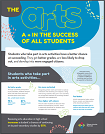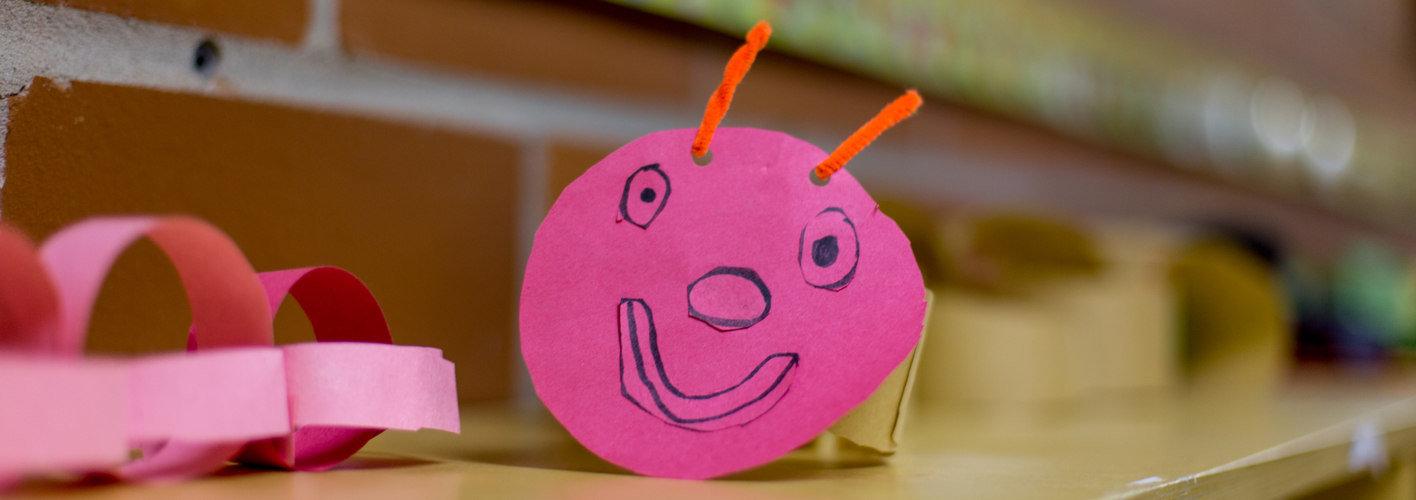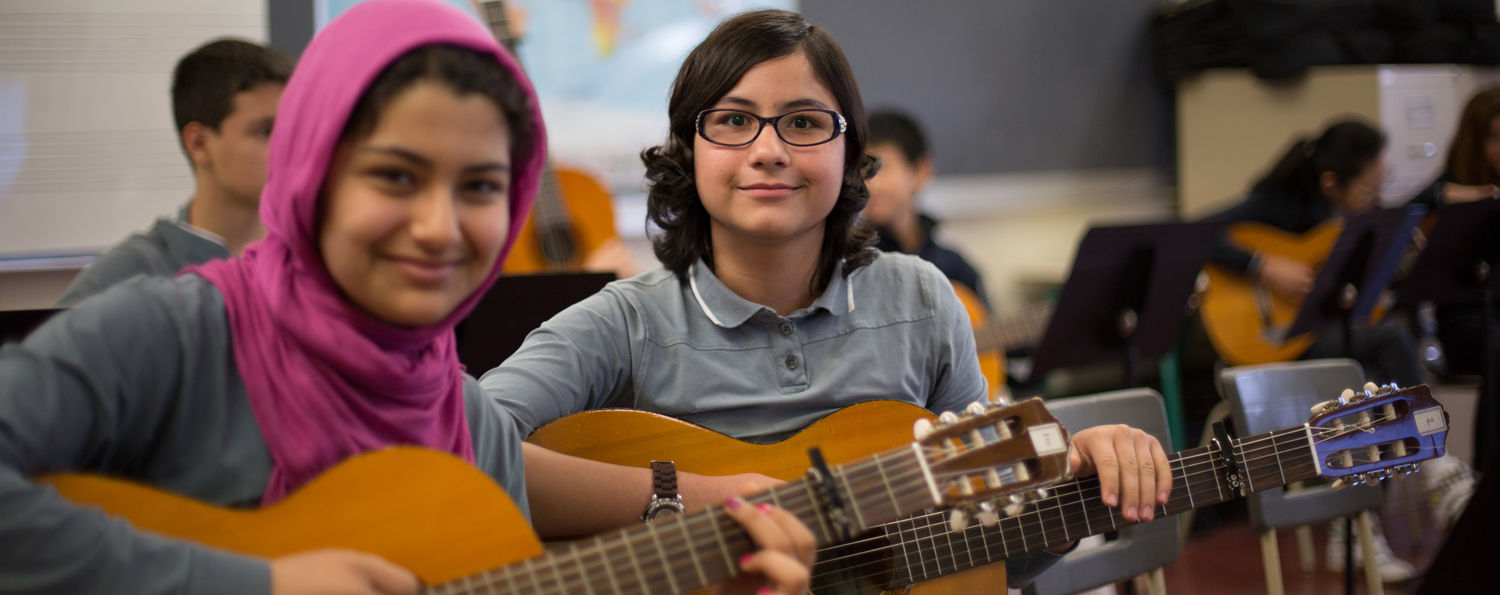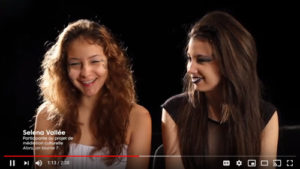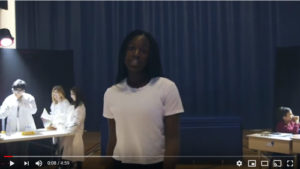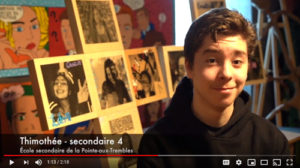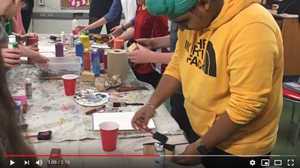
STUDENTS WHO TAKE PART IN ARTS ACTIVITIES HAVE A BETTER CHANCE AT SUCCEEDING. THEY GET BETTER GRADES, ARE LESS LIKELY TO DROP OUT, AND DEVELOP INTO MORE ENGAGED CITIZENS.
Related pages
Changes that foster success | The arts and the determinants of school perseverance | Art reduces disparity in success between: better- and worse-off students | immigrants and other students | vulnerable children and other children | Specific benefits of the arts | Conditions for success | Initiatives | The arts in action | Further reading
Participation in the arts and access to culture
Participation in arts activities and access to culture are two vital facets of an all-round education. This key topic focuses primarily on participation in arts activities, such as creating a work of art, playing an instrument, or taking part in a choreography. The benefits of access to culture, such as visiting a museum, attending a play, or listening to a piece of music will be covered in a subsequent version.
The link between the arts and educational success – an overview
THE ARTS ARE TRANSFORMATIVE AND PROMOTE SUCCESS AMONG ALL STUDENTS
Students who receive arts education in high school are 55 percent more likely to go on to post-secondary studies.1
Every additional year of arts education in a young person’s schooling increases their probability of going on to higher education by 18 percent.2
More activities = more success
Most studies conclude that increasing students’ opportunities to take part in structured arts activities corresponds to a proportional increase in their chances of success.
THE ART OF SKILLS DEVELOPMENT
The arts foster academic success by kindling a taste for learning, by promoting engagement, by teaching discipline, by developing passions, by improving attention span, and by developing a range of skills that students require for personal, academic, and professional growth.
Many of the skills acquired through the arts are useful to students long after they have finished school. These include social and professional skills that are important for navigating the 21st century world, such as critical thinking, creativity, teamwork, problem solving, communication, and leadership.3
The arts develop creativity, a vital skill for coping with everyday situations.4
THE ART OF CHANGING THE BRAIN
Neuroscience has shown that engaging in certain arts, music in particular, transforms the brain’s structure and functioning, with a notable impact on intellectual abilities. Engaging in the arts thus contributes to improving cognitive skills and, consequently, to learning other subjects.5
THE ART OF RETAINING INFORMATION
Integrating the arts into core subjects (e.g., developing a skit about a historical event or having students illustrate a section of text) demonstrates how art can help boost student engagement and enhance both learning and retention of material.6 Integrating culture into teaching core subjects (e.g., using a work of art to explain a mathematical rule or basing an English lesson on a museum exhibition) is also a proven means of enhancing learning.7
THE ART OF BOOSTING CITIZEN ENGAGEMENT
Students who have meaningful arts experiences in high school are twice as likely to do volunteer work and 20 percent more likely to vote.8
THE ART OF MENTAL AND PHYSICAL HEALTH
It is recognized that art helps reduce stress, anxiety, and depression, while boosting resilience.9
A survey of 10,000 Scots also showed that people who have visited a cultural institution or taken part in a cultural event in the past year are 60 percent more likely to say that they are in good health, regardless of age, income, socioeconomic status, education level, or physical condition.10
“Canadians who attended a performance of cultural/heritage music, theatre or dance in 2005 were 34% more likely to do a favour for a neighbour than those who did not attend.”
– Vital Signs: Arts and Belonging11
THE ARTS POSITIVELY AFFECT FACTORS RELATED TO EDUCATIONAL SUCCESS
Numerous factors and situations influence a student’s educational path. Arts education builds on the positive effect of many such factors to reduce the risk of dropout. These factors include:
ACHIEVEMENT AT SCHOOL
[learn more about this determinant]
Numerous factors contribute to how the arts improve students’ academic achievement, including the development of competencies and skills that promote learning (e.g., literacy or cognitive function) and the development of good study habits and a positive frame of mind (e.g., discipline and motivation).12
SELF-ESTEEM
[learn more about this determinant]
It is recognized that participation in arts activities boosts the confidence and self-esteem of students who struggle with core subjects, in particular by allowing them to discover their strengths in other contexts and to experience success at school.13
MOTIVATION AND ENGAGEMENT
[learn more about this determinant]
Arts education helps to boost student motivation.14 For instance, numerous studies have found a direct correlation between learning music and increased motivation.
Research has also revealed that an interest in drama can produce a high level of motivation that helps improve concentration and heighten cognitive function in various areas.15
It is interesting to note, however, the role of art among students who have a high level of school engagement. A study in Philadelphia schools found that students with high levels of engagement maintained those levels if they participated in an arts program, but if they did not participate in a program, their engagement dropped sharply.16
EDUCATIONAL AND CAREER ASPIRATIONS
[learn more about this determinant]
Experiencing various art forms allows students to discover new interests and open up new ideas about future career paths.17 In this sense, arts and culture can be a source of inspiration for students and become important motivational factors for staying in school.
The competencies and skills developed in arts education also open doors to compelling career opportunities. An analysis of international databases by the OECD highlighted that 54 percent of arts graduates hold jobs with a high potential for innovation in a range of sectors. This study also noted that the ability to innovate is essential for economic growth in a knowledge-based society.18
SELF-CONTROL AND SOCIAL AND BEHAVIOURAL CONDUCT
[learn more about this determinant]
Engaging in art has a recognized effect on self-control and the development of positive social behaviours. Research has found that art helps children learn to regulate their emotions and develop prosocial skills, which in turn reduce the risk of developing behavioural problems that might hinder their educational success.19
FEELINGS OF DEPRESSION
[learn more about this determinant]
The benefits of various art forms for mental health are well documented. It is recognized that artistic expression helps reduce stress, anxiety, and depression, while improving resilience, among other benefits.20
SCHOOL CLIMATE
[learn more about this determinant]
Many experts have noted an improvement in school climate among the positive effects of participation in arts activities, highlighting that extra-curricular activities, including the arts, are a key factor in developing a sense of belonging in the school. In certain cases, it has been observed that an improvement in school climate might also be attributed to the teamwork and mutual respect that develops among students as they take part in activities such as band or dance performances.21
More art = less misbehaviour
Research shows that every additional year of arts education is associated with a 20-percent reduction in the likelihood of being expelled from school.22
A study of 10,548 students from grades 3 to 8 in Houston, Texas also showed that increased participation in arts activities significantly reduced the proportion of students being disciplined.23
ART REDUCES DISPARITY IN SUCCESS
Having access to arts activities can contribute to reducing social and academic inequalities among some groups of students by attenuating the harmful effects of certain risk factors for the most vulnerable students.
BETWEEN DISADVANTAGED AND ADVANTAGED STUDENTS
There are up to two times as many dropouts in disadvantaged neighbourhoods.24
A longitudinal study of thousands of U.S. students showed that when students from disadvantaged backgrounds are highly exposed to the arts, they achieve results similar to, and sometimes exceeding, those of the average student.25
Among disadvantaged students, those exposed to the arts are…
5X less likely to drop out
Percentage of 13–17-year-olds who do not finish high school
(compared to an average of 7% among all students)
- Significant participation in the arts: 4%
- Low participation in the arts: 22%
More likely to embark on post-secondary studies
Percentage of students going on to post-secondary studies
- Significant participation in the arts: 71%
- Low participation in the arts: 48%
3X more likely to get a bachelor’s degree
Percentage of students obtaining a bachelor’s degree
(compared to an average of 27% among all students )
- Significant participation in the arts: 17%
- Low participation in the arts: 5%
50% more numerous in seeing themselves in professional careers (teaching, medicine, management, etc.)
Percentage of students who aspire to professional careers
(compared to an average of 38.7% among all students)
- Significant participation in the arts: 49.5%
- Low participation in the arts: 21.1%
And… more likely to read the newspaper!
Percentage of Secondary 2 students who read the newspaper at least once a week
(compared to an average of 66% among all students)
- Significant participation in the arts: 73%
- Low participation in the arts: 44%
Family socioeconomic status—a determinant of significant participation in the arts
- The likelihood of being highly exposed to the arts is twice as high in advantaged families.
- The likelihood of having low exposure to the arts is twice as high in disadvantaged families.
BETWEEN STUDENTS FROM IMMIGRANT BACKGROUNDS AND OTHER STUDENTS
Numerous factors—such as arriving during secondary education, having to learn French, and having experienced adversity—affect how students from immigrant backgrounds integrate and stay in school.
The arts and culture are powerful tools for helping these students and their families integrate, and for giving them a safe place for reflecting on their experiences from a certain distance.
A bridge between immigrants and the host society
Access to culture plays an important role in helping new arrivals learn about their new home, build ties with their new compatriots, and create a sense of belonging.
A means of communication and expression
For young people adapting to a new life and language, art helps them overcome language barriers through non-verbal communication. For those who have experienced distressing situations, art also provides an outlet for emotions and states that are difficult to talk about.
“Art takes on its full meaning when words are not enough or lacking.”
– Alexandra Perras-Chenail, Favoriser par l’art l’adaptation et l’intégration des jeunes issus de l’immigration
The power to heal
Refugees experience considerable trauma before, during, and after their migration, and studies have suggested that they are left with significant levels of post-traumatic stress and depression. This can manifest itself in children as hyperactivity, depression, anxiety, and difficulty forming bonds with others.
For these young people, artistic expression provides a means of “exploring memories and emotions in a subtle and symbolic manner […] by offering them a safe place to vent distressing traumatic symptoms.” The results of these experiences suggest that artistic activities are associated with better self-esteem and a reduction of emotional and behavioural symptoms.
Such therapy is also associated with a marked improvement in academic performance.
BETWEEN VULNERABLE AND LESS VULNERABLE CHILDREN
In Montreal 28.5 percent of kindergarten students are vulnerable in at least one developmental domain.
Studies have shown that the arts can play an important role in early childhood development and in reducing the risk of vulnerability, thereby reducing the likelihood of having difficulty in school and, ultimately, of dropping out.*
Among pre-schoolers, arts activities are generally done with a parent, a teacher, or other children. Such experiences promote development in a number of domains, in particular with respect to social skills (mutual help, sharing, empathy, etc.).
Research has also shown that dramatic play (e.g., staging a story) creates a fictional space that allows children to practice communicating and controlling their emotions. Dance activities have shown similar results in developing social and emotional skills among pre-schoolers.
Studies furthermore show that dramatic play contributes to literacy development among pre-schoolers and increases their taste for learning. Dance can also be used to support preparation for reading, and participation in plastic arts activities helps to develop overall and fine motor skills.
Finally, neurological studies show that an important predictor of phonological awareness and early childhood literacy is correlated to learning music and to brain development, underlining the connection between musical training and learning how to read.
EXAMPLES OF BENEFITS, GROUPED BY ART
Participation in arts activities promotes the development of many other competencies and skills.37
Please note that the benefits listed below are not comprehensive.
| Music | Plastic arts | Dramatic arts | Dance |
|
|
|
|
Music
Numerous studies have investigated the positive correlation between music and math grades. A broad study of a cohort of over 110,000 Canadian students concluded that taking a music course was associated with better grades in mathematics, science, and English, regardless of previous academic performance, sex, cultural background, and socioeconomic status. The association was more marked for instrumental music as compared to vocal music and was based on long-term participation. Furthermore, the higher the musical participation, the higher the test scores as well.
Additionally, neuroscience has shown a link between music and literacy. Among students who have received musical training, reading competencies are proportional to the level of musical training.
Taking part in music engages a number of processes related to executive functions, in particular those related to memory and planning, which are involved in many types of academic learning. Neurological studies have also shown that practicing music changes the brain in both its structure and how it functions, which may help explain its association with the development of cognitive processes and with academic performance.
Other hypotheses posit that practicing music helps to build effective habits that contribute to increased motivation in other subjects.
And, since ensemble music relies on teamwork, practicing music in these contexts is associated with improved school climate and social relationships.
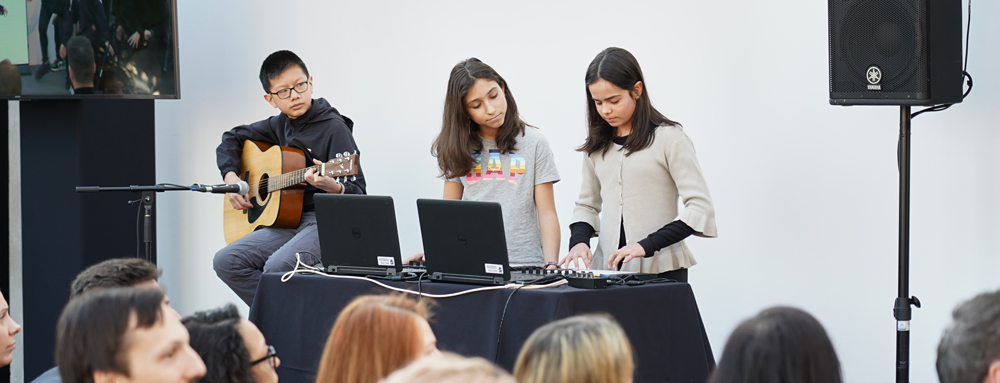 Young musicians from Académie Saint-Clément (Commission scolaire Marguerite-Bourgeoys) at the Montreal launch of Hooked on School Days 2020 at the Montreal Museum of Fine Arts. Photo: Sylvain Légaré
Young musicians from Académie Saint-Clément (Commission scolaire Marguerite-Bourgeoys) at the Montreal launch of Hooked on School Days 2020 at the Montreal Museum of Fine Arts. Photo: Sylvain Légaré
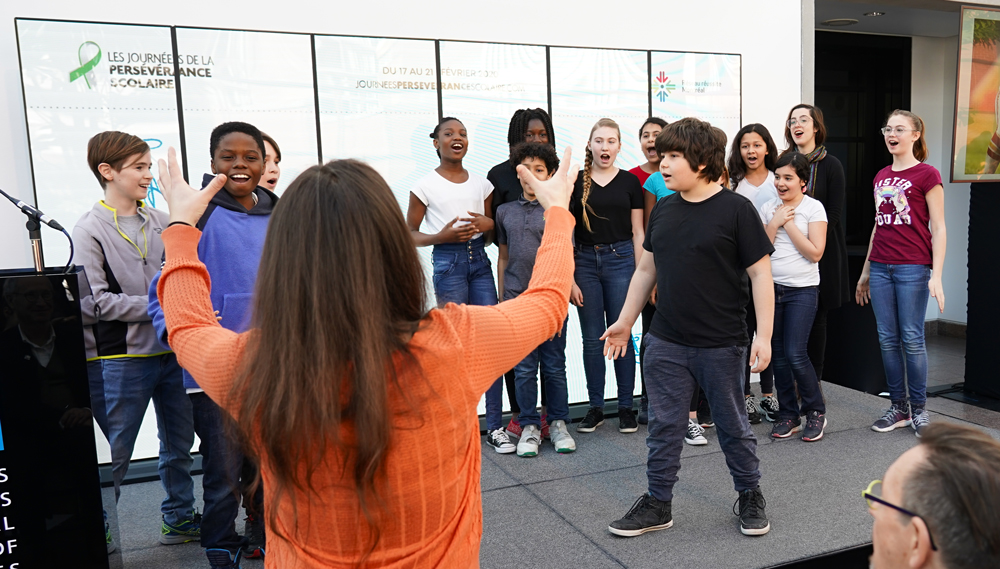 Students from the CoOpéra projet pay tribute to Laurent Duvernay-Tardif at the Montreal launch of Hooked on School Days 2020 at the Montreal Museum of Fine Arts. Photo: Sylvain Légaré
Students from the CoOpéra projet pay tribute to Laurent Duvernay-Tardif at the Montreal launch of Hooked on School Days 2020 at the Montreal Museum of Fine Arts. Photo: Sylvain Légaré
PLASTIC ARTS
In addition to creativity, plastic arts develop spatial and visual memory.
The need to make choices is also inherent in the plastic arts—which tool to employ, which colours to use, how to represent the idea, etc. So this art form develops one’s ability to make decisions.
Because many changes can occur throughout the creative process, between a work’s conception and completion, art also draws on one’s ability to adapt.
Finally, a work of art expresses a personal and unique perspective, which fosters improved self-knowledge as the work is created.
From a therapeutic standpoint, the creative arts help one imagine different possibilities outside the present moment—an especially helpful ability during times of adversity. Studies have also shown that the visual arts activate the brain’s reward system, which is why these activities are perceived as enjoyable.
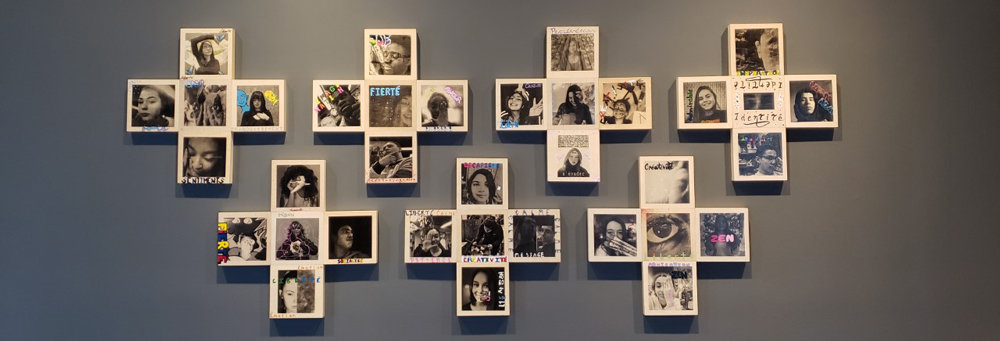 Students from Pointe-aux-Trembles high school (Commission scolaire de la Pointe-de-l’Île) made these works of art especially for the Montreal launch of Hooked on School Days 2020 at the Montreal Museum of Fine Arts. Photo: Sylvain Légaré
Students from Pointe-aux-Trembles high school (Commission scolaire de la Pointe-de-l’Île) made these works of art especially for the Montreal launch of Hooked on School Days 2020 at the Montreal Museum of Fine Arts. Photo: Sylvain Légaré
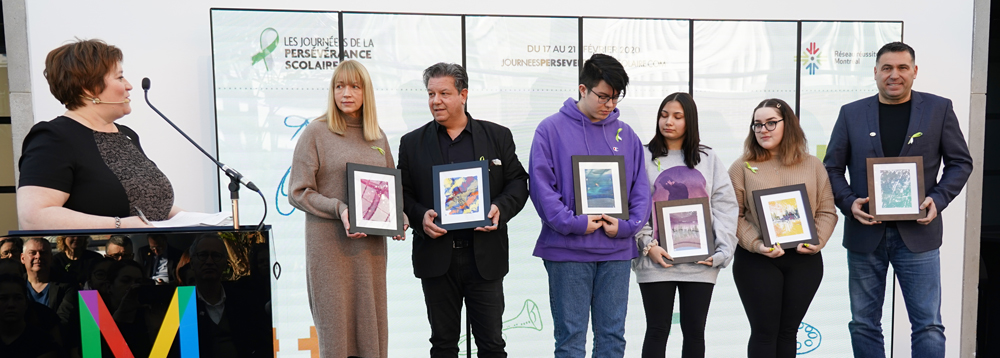 The results of a printmaking workshop at Lindsay Place High school (Lester B. Pearson Scool Board) – Montreal launch of Hooked on School Days 2020 at the Montreal Museum of Fine Arts. Photo: Sylvain Légaré
The results of a printmaking workshop at Lindsay Place High school (Lester B. Pearson Scool Board) – Montreal launch of Hooked on School Days 2020 at the Montreal Museum of Fine Arts. Photo: Sylvain Légaré
DRAMATIC ARTS
The dramatic arts are known to contribute to the development of empathy and an understanding of other perspectives, as students are asked to put themselves in someone else’s place.
Drama also has numerous benefits in terms of developing literacy skills, in particular with respect to reading, reading comprehension, and story comprehension.
Notable among the other possible benefits of this art form is that an interest in the dramatic arts can lead to a high level of motivation, which helps to develop concentration and improve cognitive functions in various domains.
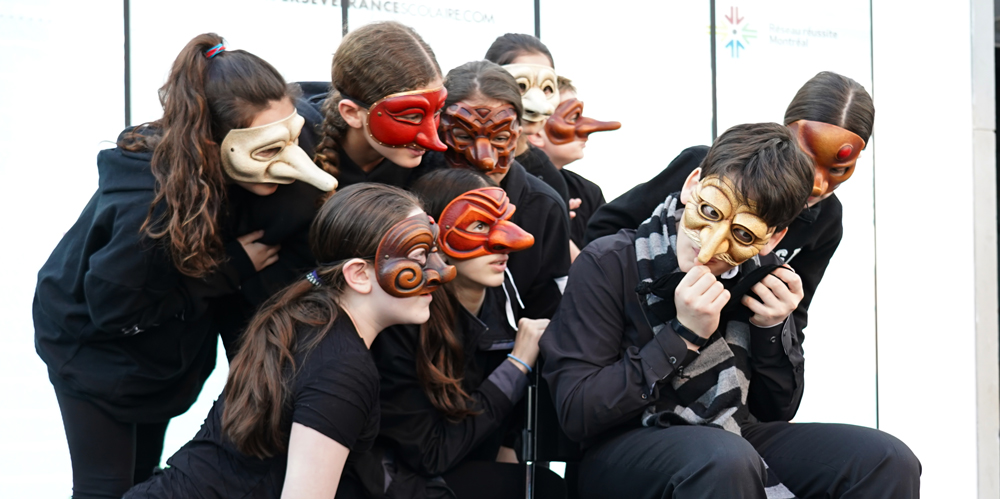 Young actors from Royal Vale School (English-Montreal School Board) perform at the Montreal launch of Hooked on School Days 2020 at the Montreal Museum of Fine Arts. Photo: Sylvain Légaré
Young actors from Royal Vale School (English-Montreal School Board) perform at the Montreal launch of Hooked on School Days 2020 at the Montreal Museum of Fine Arts. Photo: Sylvain Légaré
Dance
Many schools that have added dance programs to their curricula have noted improvements in students’ abilities to cooperate, improved tolerance of others, and increased mutual respect among students.
It should also be noted that dance encourages physical activity, which has well-known benefits for health, well-being, concentration, and behaviour in class.
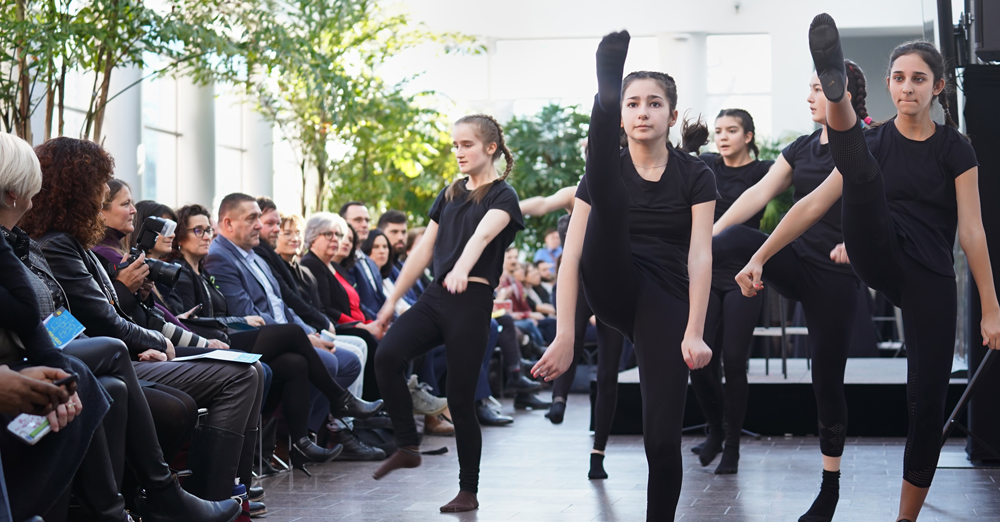 « Résilience » – A dance performance by students from FACE (Commission scolaire de Montréal) at the Montreal launch of Hooked on School Days 2020 at the Montreal Museum of Fine Arts. Photo : Sylvain Légaré
« Résilience » – A dance performance by students from FACE (Commission scolaire de Montréal) at the Montreal launch of Hooked on School Days 2020 at the Montreal Museum of Fine Arts. Photo : Sylvain Légaré
CONDITIONS OF SUCCESS—STRUCTURE AND DEGREE OF EXPOSURE
While most studies are unanimous on the benefits of engaging in the arts, they also agree on the conditions for success. Like any beneficial practice, arts activities must be structured, and participation must be sustained over time. Consequently, the magnitude of the benefit is correlated to the degree of exposure to the arts.
Initiatives
Recognizing the vital role that arts and culture play in educational success, numerous Montreal-based initiatives enable students to benefit from engaging in the arts and accessing culture.
(Please note that this list is incomplete and will continue to grow.)
- The arts and culture projects coordinated by Une école montréalaise pour tous (French only)
- The Montreal Museum of Fine Arts’ Educart teaching tool and the School at the Museum project
- The Passeurs de rêve and Hémisphères programs of Culture pour tous!
- The partnership between the ministère de l’Éducation et de l’Enseignement supérieur and the ministère de la Culture et des Communications (French only) to support actions that combine education and culture
- The community of arts and culture specialists within the Coalition nationale pour une éducation artistique de qualité (CNÉAQ) (French only), which supports the teaching of all four arts in schools.
Arts and cultural activities for greater social justice
Through its ongoing work with Montreal’s culture sector, Une école montréalaise pour tous (UEMPT) has become a specialist in arts and cultural activities.
—->Learn more about the practices and approaches of UEMPT. (French only)
ARTS IN ACTION
Here are just a few examples of the many arts activities in Montreal schools. (The videos below were provided to us for the launch of the Hooked on School Days event in Montreal.)
Dance: express for success
Three students who were introduced to the world of modern dance through the cultural mediation project Alors, on tourne? speak about what dance means to them. A video by Circuit-Est, produced in partnership with the Commission scolaire de Montréal.
“Mon école est mon fort”: A hymn to school perseverance
Grade 5 students at Émile-Nelligan elementary school, guided by the school’s drama teacher, John R. Cadet, and special education technician Vanessa Gippert, created a video of a song about perseverance, effort, and the importance of believing in yourself.
The arts and school perseverance – plastic arts
Alyssandra, Thimothée, and Audrey-Ann, students at Pointe-aux-Trembles high school, show what art means to them and what they get out of arts activities. The video was produced by the Commission scolaire de la Pointe-de-l’Île.
Printmaking workshop at Lindsay Place High School
This video shows students at Lindsay Place High school engaged in a printmaking workshop at Hi-Innovation studio. Watch the video to see their works of art. A production of the Lester B. Pearson School Board.
FURTHER READING
- Arts education – Arts Research Monitor (Hill Strategies)
- The Arts and Achievement in At-Risk Youth: Findings from Four Longitudinal Studies (National Endowment for the Arts)
- A Population-Level Analysis of Associations Between School Music Participation and Academic Achievement (Journal of Educational Psychology)
- Dropout Prevention: The Power of Art to Engage (National Dropout Prevention Center/Network)
- The value of arts and culture to people and society: an evidence review (Arts Council England)
- The arts in early childhood: social and emotional benefits of arts participation, a literature review and gap-analysis (2000-2015) (National Endowment for the Arts)
- Neuroeducation : Learning, Arts, and the Brain – Finding s and Challenges for Educators and Researchers from the 2009 Johns Hopkins University Summit (Dana Press)
- The Role of Culture and the Arts as a Framework and Tool for Settlement (Canadian Commission for UNESCO)
- Art for Art’s Sake? Overview (OECD)
*It is important to note that “vulnerable” students may have a different set of life experiences than those typically anticipated by the school. It is also worth noting that vulnerable children are not predestined for failure and that appropriate support can facilitate their path to success.
1. Kenneth Elpus, ‟Arts Education and Positive Youth Development: Cognitive, Behavioral, and Social Outcomes of Adolescents who Study the Arts,” 2013.
2. Ibid.
3. Thomas Bastien, Anik Meunier, Julie Rose and Catherine Quintal, Des écoles, une journée à la fois!, UQAM, GREM, CREDO and MMFA.
4. “Les arts à l’école: ‘juste’ du bricolage?” La Presse, May 7, 2018.
5. James S. Catterall, Richard Chapleau, John Iwanaga, ‟Involvement in the Arts and Human Development: General Involvement and Intensive Involvement in Music and Theatre Arts,” The Imagination Project at UCLA Graduate School of Education & Information Studies, University of California at Los Angeles, July 1999. | Guhn, M., Emerson, S. D., & Gouzouasis, P., ‟A Population-Level Analysis of Associations Between School Music Participation and Academic Achievement,” Journal of Educational Psychology, 2019, June 24. | Mariale Hardiman, Ed.D., Susan Magsamen, Guy McKhann, M.D., and Janet Eilber, ‟Neuroeducation: Learning, Arts, and the Brain – Findings and Challenges for Educators and Researchers from the 2009 Johns Hopkins University Summit,” Dana Press, 2009.
6. ‟How Integrating Arts Into Other Subjects Makes Learning Come Alive,” KQED, January 13, 2015.
7. Anik Meunier and Frédérique Bédard Daneau, Le projet pilote Musée-école du Musée des beaux-arts de Montréal, GREM-UQAM.
8. Andrew Mowlah, Vivien Niblett, Jonathon Blackburn and Marie Harris, ‟The Value of Arts and Culture to People and Society: An Evidence Review,” Arts Council England, March 2014.
9. ‟The Healing Power of Art,” Harvard health Publishing, July 2017.
10. Andrew Mowlah, Vivien Niblett, Jonathon Blackburn and Marie Harris, ‟The Value of Arts and Culture to People and Society: An Evidence Review,” Arts Council England, March 2014.
11. Vital Signs: Arts and Belonging, Community Foundations of Canada and Canadian Arts Presenting Association (CAPACOA), April 2017.
12. James S. Catterall, Richard Chapleau, John Iwanaga, ‟Involvement in the Arts and Human Development: General Involvement and Intensive Involvement In Music and Theatre Arts,” The Imagination Project at UCLA Graduate School of Education & Information Studies, University of California at Los Angeles, July 1999. | James S. Catterall (University of California Los Angeles) with Susan A. Dumais (Louisiana State University) and Gillian Hampden-Thompson (University of York U.K.), ‟The Arts and Achievement in At-Risk Youth: Findings from Four Longitudinal Studies,” National Endowment for the Arts, March 2012 | Sandra S. Ruppert, ‟Critical Evidence: How the ARTS Benefit Student Achievement,” National Assembly of State Arts Agencies and the Arts Education Partnership, 2006. | Guhn, M., Emerson, S. D., & Gouzouasis, P., ‟A Population-Level Analysis of Associations Between School Music Participation and Academic Achievement,” Journal of Educational Psychology, 2019, June 24.
13. Mariale Hardiman, Ed.D., Susan Magsamen, Guy McKhann, M.D., and Janet Eilber, ‟Neuroeducation: Learning, Arts, and the Brain – Findings and Challenges for Educators and Researchers from the 2009 Johns Hopkins University Summit,” Dana Press, 2009. | “Pourquoi apprendre les arts à l’école?” Alloprof, February 22, 2018. | Alexandra Perras-Chenail, Favoriser par l’art l’adaptation et l’intégration des jeunes issus de l’immigration: étude de quelques projets dans les organismes communautaires et dans le milieu scolaire montréalais, January 2008.
14. Kimberley Brown, ‟Dropout Prevention: The Power of Art to Engage,” National Dropout Prevention Center/Network, October 2017.
15. Mariale Hardiman, Ed.D., Susan Magsamen, Guy McKhann, M.D., and Janet Eilber, ‟Neuroeducation: Learning, Arts, and the Brain – Findings and Challenges for Educators and Researchers from the 2009 Johns Hopkins University Summit,” Dana Press, 2009.
16. Kimberley Brown, ‟Dropout Prevention: The Power of Art to Engage,” National Dropout Prevention Center/Network, October 2017.
17. Douglas Israel, ‟Staying in School: Arts Education and New York City High School Graduation Rates,” The Center for Arts Education, 2009.
18. Winner, E., T. Goldstein and S. Vincent-Lancrin, ‟Art for Art’s Sake? Overview,” OECD Publishing, 2013.
19. Andrew Mowlah, Vivien Niblett, Jonathon Blackburn and Marie Harris, ‟The Value of Arts and Culture to People and Society: An Evidence Review,” Arts Council England, March 2014. | Kimberley Brown, ‟Dropout Prevention: The Power of Art to Engage,” National Dropout Prevention Center/Network, October 2017. | Melissa Menzer, ‟The Arts in Early Childhood: Social and Emotional Benefits of Arts Participation, A Literature Review and Gap-analysis (2000–2015),” National Endowment for the Arts, December 2015.
20. ‟Feeling Artsy? Here’s How Making Art Helps Your Brain,” NPR (National Public Radio), January 11, 2020. | Vital Signs: Arts and Belonging, Community Foundations of Canada and Canadian Arts Presenting Association (CAPACOA), April 2017. | Guhn, M., Emerson, S. D., & Gouzouasis, P., ‟A Population-Level Analysis of Associations Between School Music Participation and Academic Achievement,” Journal of Educational Psychology, 2019, June 24. | ‟The Healing Power of Art,” Harvard Health Publishing, July 2017.
21. ‟New Evidence of the Benefits of Arts Education,” Brookings, February 12, 2019. | Guhn, M., Emerson, S. D., & Gouzouasis, P., ‟A Population-Level Analysis of Associations Between School Music Participation and Academic Achievement,” Journal of Educational Psychology, 2019, June 24. | ‟Why Dance Is Just as Important as Math in School,” Ideas.Ted.Com, March 21, 2018.
22. Kenneth Elpus, ‟Arts Education and Positive Youth Development: Cognitive, Behavioral, and Social Outcomes of Adolescents who Study the Arts,” 2013.
23. Daniel H. Bowen, Ph.D. and Brian Kisida, Ph.D., ‟Investigating Causal Effects of Arts Education Experiences: Experimental Evidence from Houston’s Arts Access Initiative,” Research Report for the Houston Independent School District, 7 (4) February, 2019.
24. Réunir Réussir, Taking Effective Action on the Determinants of School Perseverance and Educational Success, fact sheet 17: Neighbourhood of Residence , 2013.
25. James S. Catterall (University of California Los Angeles) with Susan A. Dumais (Louisiana State University) and Gillian Hampden-Thompson (University of York U.K.), ‟The Arts and Achievement in At-Risk Youth: Findings from Four Longitudinal Studies,” National Endowment for the Arts, March 2012.
26. James S. Catterall, Richard Chapleau, John Iwanaga, ‟Involvement in the Arts and Human Development: General Involvement and Intensive Involvement in Music and Theatre Arts,” The Imagination Project at UCLA Graduate School of Education & Information Studies, University of California at Los Angeles, July 1999.
27. Vital Signs: Arts and Belonging, Community Foundations of Canada and Canadian Arts Presenting Association (CAPACOA), April 2017. | Daniel Hiebert and Bronwyn Bragg, The Role of Culture and the Arts as a Framework and Tool for Settlement, Canadian Commission for UNESCO, January 2018.
28. AAlexandra Perras-Chenail, Favoriser par l’art l’adaptation et l’intégration des jeunes issus de l’immigration: étude de quelques projets dans les organismes communautaires et dans le milieu scolaire montréalais, January 2008. | Daniel Hiebert and Bronwyn Bragg, The Role of Culture and the Arts as a Framework and Tool for Settlement, Canadian Commission for UNESCO, January 2018.
29. Daniel Hiebert and Bronwyn Bragg, The Role of Culture and the Arts as a Framework and Tool for Settlement, Canadian Commission for UNESCO, January 2018. | Cécile Rousseau, Louise Lacroix, and Aline Drapeau, ‟Evaluation of a classroom program of creative expression workshops for refugee and immigrant children,” Journal of Child Psychology and Psychiatry, March 2005.
30. Cécile Rousseau, Louise Lacroix, ‟Creative Expression Workshops in School: Prevention Programs for Immigrant and Refugee Children,” The Canadian Child and Adolescent Psychiatry Review, September 2005.
31. Institut de la statistique du Québec, Québec Survey of Child Development in Kindergarten 2017, 2018.
32. Melissa Menzer, ‟The Arts in Early Childhood: Social and Emotional Benefits of Arts Participation, A Literature Review and Gap-analysis (2000–2015),” National Endowment for the Arts, December 2015.
33. Ibid.
34. Sandra S. Ruppert, ‟Critical Evidence: How the ARTS Benefit Student Achievement,” National Assembly of State Arts Agencies and the Arts Education Partnership, 2006. | Andrew Mowlah, Vivien Niblett, Jonathon Blackburn and Marie Harris, ‟The Value of Arts and Culture to People and Society: An Evidence Review,” Arts Council England, March 2014.
35. “Pourquoi apprendre les arts à l’école?” Alloprof, February 22, 2018. | Melissa Menzer, ‟The Arts in Early Childhood: Social and Emotional Benefits of Arts Participation, A Literature Review and Gap-analysis (2000–2015),” National Endowment for the Arts, December 2015.
36. Mariale Hardiman, Ed.D., Susan Magsamen, Guy McKhann, M.D., and Janet Eilber, ‟Neuroeducation: Learning, Arts, and the Brain – Findings and Challenges for Educators and Researchers from the 2009 Johns Hopkins University Summit,” Dana Press, 2009.
37. The benefits listed in this section come from the references cited above.





